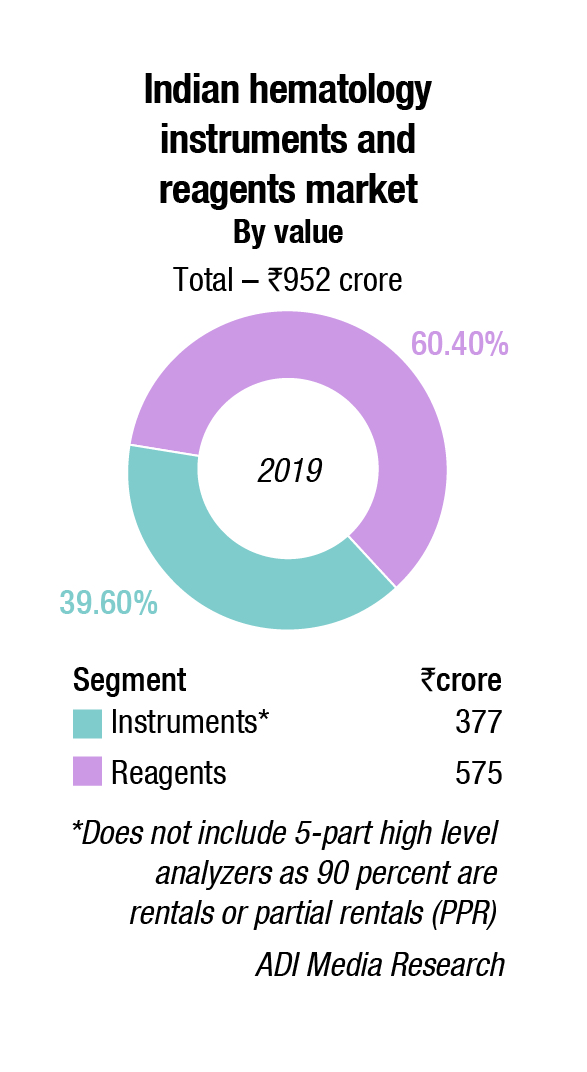Hematology Instruments and Reagents
Hematology, inclining toward highly sensitive and efficient analysis

The recent pandemic has created a huge demand in hematology testing where a low WBC count, along with a decreased lymphocyte count is of importance in the early stages of the disease.
 Over the past decades, hematology analyzers have experienced great technical advancements, featuring low turnaround time, enhanced precision, and accuracy. The challenges associated with manual methods like immature cells, reliability on results, distribution error, and statistical error are being replaced with precise, safe, and dependable automated hematology systems.
Over the past decades, hematology analyzers have experienced great technical advancements, featuring low turnaround time, enhanced precision, and accuracy. The challenges associated with manual methods like immature cells, reliability on results, distribution error, and statistical error are being replaced with precise, safe, and dependable automated hematology systems.
Out of the existing 110,000 laboratories in India, more than 40,000 laboratories are in the Tier-II and Tier-III cities, covering the rural and semi-urban population with limited access to majority of IVD technologies. As per statistics, more than 70 percent of the Indian population lives in the rural areas, and the benefits of IVD technologies remain underserved to the patients in these rural areas. One of the major changes in the hematology segment is the introduction of highly compact 3-part and 5-part hematology systems. These compact systems are well suited for rural India, and are expected to bring in changes in the IVD industry.
Recent developments
A number of technological solutions have been developed for laboratory hematology in recent times. These basically include: commercialization of modular, high-throughput and versatile analyzers, which can be easily interconnected by means of sample conveyers, and can fit the organization of small, medium and large facilities; integration of pre-analytical workstations, which can be identical to those included in models of total laboratory automation, or can be specifically designed to suit hematological testing; connection with automated slide strainers, which help improving the entire slide making process; as well as integration of automated image analysis systems.
Throughout the relatively long history of laboratory hematology, the only reliable means for identifying, enumerating and sizing blood cells has been for long represented by optical microscopy of peripheral blood smear. This practice carries many drawbacks, since it is inevitably time-consuming, is vulnerable to high inter- and intra-observer inaccuracy and imprecision, needs specific education and training of microscopists, and is poorly suited for rapid diagnostics as otherwise needed in patients with many acute hematological disorders.
 “The ongoing COVID pandemic has reiterated to the entire mankind the importance of health and healthcare facilities. The current times and the era to ensue will see the increasing need for laboratory automation, emphasis on quality services, and the need to reach the people within the confines of their homes.”
“The ongoing COVID pandemic has reiterated to the entire mankind the importance of health and healthcare facilities. The current times and the era to ensue will see the increasing need for laboratory automation, emphasis on quality services, and the need to reach the people within the confines of their homes.”
Dr Sonal Jain
Head Hematology, Dr Dang’s Lab Pvt Ltd, New Delhi
Recent technological advances have led to development and commercialization of innovative automated image analysis systems, which are suited for automation and can hence be directly connected (in series) with hematologic analyzers.
These innovative platforms scan the slides (usually at a picture of ×100 objective), and store digitalized images of blood smears at high magnification. The images are analyzed by artificial neural networks based on a preexisting database of blood elements (thus including RBC), which can be locally customized or updated by the users. The images can be transmitted to, and displayed on, computer screens, which can be even placed at long distances from the scanner, for analysis and potential reclassification of blood elements.
The operator can also increase the size of the images, or expand single sections of the scan, so obtaining a more accurate view. The operator can then accept and conserve the automatic classification, or can move elements from one cell category to another, thus improving the final reclassification. Albeit these automated image analysis systems have been originally developed for analysis of white blood cells (WBC), specific information can also be garnered on erythrocyte morphology, thus including the presence of anysocytosis, hypochromia, microcytosis or macrocytosis, spherocytosis, elliptocytosis, ovalocytosis, stomatocytosis, acanthocytosis, echinocytosis, polychromasia, poikilocytosis, and abnormal erythrocytes. Recent data showed that the diagnostic sensitivity of these systems for identifying some critical categories of abnormal erythrocytes is excellent, typically higher than 80 percent, thus making the use of digital image analysis a highly valuable, and probably more accurate and reproducible, alternative to optical microscopy.
Notably, the use of these systems may also enable an efficient recognition of parasitoid infections such as malaria, as well as the reliable identification of intravascular and spurious hemolysis, which would be otherwise undetectable on whole blood specimens. Interestingly, most of these automated image analysis systems are also capable of optimizing the identification of rare RBC abnormalities, since morphological erythrocyte alterations can be more efficiently visualized on the computer screen. Finally, the creation of a large personalized database of images of suggestive RBC abnormalities represents a valuable resource for education and training of students and laboratory professionals.
The foundation knowledge related to benign and malignant hematology is also evolving with the application of AI in hematology. Even the most skilled hematology specialist can overlook the patterns, deviations, and relations among the vast number of blood parameter measures by modern analyzers. In contrast, the AI algorithm can easily analyze hundreds of attributes (parameters) simultaneously with correlation, and recognize a pattern or fingerprint of certain hematological abnormality. The machine learning (ML) algorithms can uncover the disease-related patterns in a blood test that may be beyond medical knowledge, resulting in higher diagnostic accuracy as compared to traditional quantitative interpretation, based only over reference ranges. Also, it can lead to a fundamental change in differential diagnosis and result in the modifications in the presently accepted guidelines.
What’s ahead
The hematology market in India is dependent on imports – the major suppliers being from China, Europe, Japan, and USA. The current inflation in the forex rates is one of the major concerns in the Indian hematology segment. The recent pandemic has created a huge demand in hematology testing where a low WBC count, along with a decreased lymphocyte count, is of importance in the early stages of the disease, further adding to the industry’s woes on cost of testing.
Indigenous hematology systems are in the pipeline with state-of-the-art technology to suit the Indian scenario, and these are expected to hit the market in the coming months. It is expected that with local manufacturing both the hardware and consumable cost of CBC testing will be reduced drastically, and it will bring down the dependency of our country on imports. This first indigenously developed and manufactured 3-part hematology analyzer will change the overall market of hematology, which is long awaited since more than five decades.












